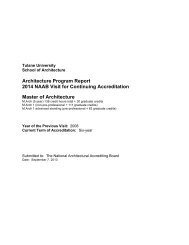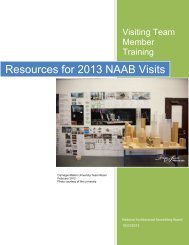Architecture Program Report Tulane University New Orleans ...
Architecture Program Report Tulane University New Orleans ...
Architecture Program Report Tulane University New Orleans ...
Create successful ePaper yourself
Turn your PDF publications into a flip-book with our unique Google optimized e-Paper software.
4.2 STUDIO CULTURE POLICY (DRAFT)<br />
The Design Studio is the center of the <strong>Architecture</strong> School’s curriculum. Learning<br />
in a studio format may be radically different from other types of academic<br />
experience with which you are more familiar. Perhaps the most dramatic change<br />
will be a shift in your communications base from the more traditional use of<br />
verbal, textual, and numerical language to a significant reliance upon drawings,<br />
models, and other graphic means of communication. To you this shift may seem<br />
to remove a degree of certainty from communication, while to the instructors it is<br />
a far more efficient means of addressing the multiple contingencies of design<br />
work. Though many of your architecture courses are lecture based, with<br />
traditional means of evaluation, most of the synthesizing of new information—<br />
essential to a design education—happens in the design studio. <strong>Architecture</strong> is a<br />
highly synthetic discourse, combining information from a broad range of sources;<br />
and the design studio is the physical and intellectual site of that synthesis.<br />
Criticism<br />
The role of faculty in the design studio is that of a critic. In some schools of<br />
architecture studio instructors are called “critics.” Criticism in this sense is not<br />
pejorative, but is meant to imply analysis, and commentary rather than<br />
faultfinding. The issues discussed are intended to focus and provide insight into<br />
the principal questions of a design problem. A critique is a discussion which may<br />
or may not contain specific suggestions. Even when critique is principally<br />
socratic, that is, based upon questioning, emphases and suggested directions<br />
are being implied. Since there is no “single right answer” to a given design<br />
project, instructors are neither giving away nor withholding secrets to success.<br />
The question of whether or not an instructor “likes” a project is among the least<br />
relevant issues that can be gathered from a critique. Above all, please remember<br />
that comments made by a critic concern the design work at hand and are not<br />
personal.<br />
Critique Formats<br />
The critique of student work is typically done in one of three formats: (1)<br />
individual discussions between a student and an instructor at a students desk (a<br />
“desk-crit.”); (2) small, informal group discussions about projects pinned to a wall<br />
(a “pinup”); or (3) formal presentations of student projects made to a panel of<br />
critics participating in discussion (a “review”). The last of these, the review, is an<br />
important event in the course of a design investigation. Students present their<br />
work to a panel which often includes faculty, visiting architects, and fellow<br />
students. All are invited to give commentary on the work, opening up a<br />
discussion of important issues. A review, like any critique, is not a grading<br />
session but rather a forum for discussion. Often, you will gain significant insight<br />
into your own work by discussing and considering the work of your classmates.<br />
Though individual projects are often discussed separately, a review is as much.<br />
In general














